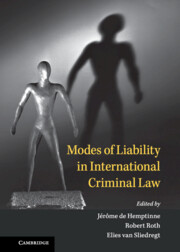Book contents
- Modes of Liability in International Criminal Law
- Modes of Liability in International Criminal Law
- Copyright page
- Contents
- Biographies
- Acknowledgements
- Abbreviations
- 1 Cross-Cutting Issues
- Part I Individual Commission
- Part II Joint Commission
- 5 Co-Perpetration Based on Joint Control over the Crime
- 6 Joint Criminal Enterprise
- Part III Participation
- Part IV Participating in Group Activities
- Part V Inchoate and Preparatory Acts
- Part VI Other Forms of Responsibility
- Part VII Concluding Observations
- Index
- References
6 - Joint Criminal Enterprise
from Part II - Joint Commission
Published online by Cambridge University Press: 01 July 2019
- Modes of Liability in International Criminal Law
- Modes of Liability in International Criminal Law
- Copyright page
- Contents
- Biographies
- Acknowledgements
- Abbreviations
- 1 Cross-Cutting Issues
- Part I Individual Commission
- Part II Joint Commission
- 5 Co-Perpetration Based on Joint Control over the Crime
- 6 Joint Criminal Enterprise
- Part III Participation
- Part IV Participating in Group Activities
- Part V Inchoate and Preparatory Acts
- Part VI Other Forms of Responsibility
- Part VII Concluding Observations
- Index
- References
Summary
The concept of joint criminal enterprise (JCE) has been regarded as one of the most important modes of liability in ICL, which some scholars and practitioners have praised for ‘ensuring that individual culpability is not obscured in the fog of collective criminality and accountability evaded’. Indeed, ever since it was first articulated by the ICTY Appeals Chamber in the Tadić case, JCE liability has been widely applied in the case law of both the ICTY and the ICTR, and it was subsequently also adopted by the SCSL, the ECCC and the STL.Nowadays, it is well established that JCE is a form of co-perpetration, which applies in cases where a plurality of individuals share a common criminal purpose and coordinate efforts to commit its underlying crime.
- Type
- Chapter
- Information
- Modes of Liability in International Criminal Law , pp. 121 - 170Publisher: Cambridge University PressPrint publication year: 2019

